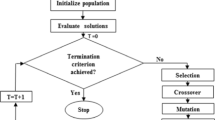Abstract
Conditionally breeding real-coded genetic algorithm (CGAR) is effective approach for continue domain problems, in which crossover and mutation behaviors are performed by difference-degree between individuals instead of given probability. In this paper we present a novel exploitation scheme for CGAR to balance between two contradictory aspects of its performance: exploration and exploitation, which is aimed at improving its ability to converge to the near-optimal solutions. The proposed algorithms are evaluated on a number of benchmark functions and the simulation results show that the proposed algorithm performs quite well and outperforms other algorithms.






Similar content being viewed by others
References
Ackley H (1987) An empirical study of bit vector function optimization. Genet Algorithm Simulated Annealing 1:170–204
Akimoto Y, Hasada R, Sakuma J (2007) Generation alternation model for real-coded ga using multi-parent: proposal and evaluation of just generation gap (JGG). In Proceedings of the 19th SICE Symposium on Decentralized Autonomous Systems 2007; 341–346
Bilchev G, Parmee IC (1995) The ant colony metaphor for searching continuous design spaces. Evol Comput: AISB Work 993:25–39
Boumkheld N, Ghogho M, El Koutbi M (2015) Energy consumption scheduling in a smart grid including renewable energy a smart grid including renewable energy. J Inf Process Syst 11(1):116–124
Chen ZQ, Wang RL (2011) A new framework with FDPP-LX crossover for real-coded genetic algorithm. IEICE Trans Fundam Electron, Commun Comput Sci; E94. A(6): 417–1425
Chen ZQ, Wang RL (2011) Two efficient real-coded genetic algorithms for real parameter optimization. Int J Innov Comput Inf Control 7(8):4871–4883
Deb K, Anand A, Joshi D (2002) A computationally efficient evolutionary algorithm for real-parameter evolution. Evol Comput J 10:371–395
Deep K, Thakur M (2007) A new crossover operator for real coded genetic algorithms. Appl Math Comput 188:895–911
Eshelman LJ (1998) The chc adaptive search algorithm: how to have safe search when engaging in nontraditional genetic recombination. Found Genet Algorithm. 1:265–283
Goldberg DE (1989) Genetic algorithms in search, optimization, and machine learning. Addison Wsley Publishing Company Inc, New Jersey
Gupta GP, Misra M, Garg K (2015) An energy efficient distributed approach-based agent migration scheme for data aggregation in wireless sensor networks. J Inf Process Syst 11(1):148–164
Juan C (2013) Augusto, Vic Callaghan, Diane Cook. Intelligent environments: a manifesto. Hum-centric Comput Inf Sci 3:12
Jyoti A, Sarabjeet Singh B (2015) Implementation of hybrid image fusion technique for feature enhancement in medical diagnosis. Hum-centric Comput Inf Sci 5:3
Kobayashi S (2009) The frontiers of real-coded genetic algorithms. J Jpn Soc Artif Intell 24(1):128–143
Kumar KP, Geethakumari G (2014) Detecting misinformation in online social networks using cognitive psychology. Hum-centric Comput Inf Sci 4:14
Lee H-G, Park S-Y, Rim H-C (2015) A maximum entropy-based bio-molecular event extraction model that considers event generation. J Inf Process Syst 11(2):248–265
Li C, Liang M, Wang T (2015) Criterion fusion for spectral segmentation and its application to optimal demodulation of bearing vibration signals. Mech Syst Sig Process. doi.10.1016/j.ymssp.2015.04.004
Liu S, Cheng X, Fu W (2014) Numeric characteristics of generalized M-set with its asymptote. Appl Math Comput 243:767–774
Liu S, Fu W, He L (2015) Distribution of primary additional errors in fractal encoding method. Multimed Tools Appl. doi:10.1007/s11042-014-2408-1
Liu S, Zhang Z, Qi L et al (2015) A fractal image encoding method based on statistical loss used in agricultural image compression. Multimed Tools Appl. doi:10.1007/s11042-014-2446-8
Lv Z, Halawani A, Feng S, Li H, Réhman SU (2014). Multimodal hand and foot gesture interaction for handheld devices. ACM Trans Multimed Comput Commun Appl (TOMM)2014; 11(1s): 10:1–10:19
Lv Z, Halawani A, Feng S (2015) Touch-less interactive augmented reality game on vision based wearable device. Pers Ubiquit Comput 19(3–4):551–567
Michalewicz Z (1992) Genetic algorithms + data structures = evolution programs. Springer, New York
Monmarche N, Venturini G, Slimane M (2000) On how pachycondylaapicalis ants suggest a new search algorithm. Futur Gener Comput Syst 16(8):937–946
Ono I, Kobayashi S (1997) A real-coded genetic algorithm for function optimization using unimodal normal distribution crossover. in: Back T (ed), Proceedings of the Seventh International Conference on Genetic Algorithms, Morgan Kaufmann, San Mateo, CA 1997; 246–253
Price KV, Storn RM, Lampinen JA. Differential evolution: a practical approach to global optimization. Springer 2005
Qin AK, Huang VL, Suganthan PN (2009) Differential evolution algorithm with strategy adaptation for global numerical optimization. IEEE Trans Evol Comput 13(2):398–417
Rosenbrock HH (1960) An automatic method for finding the greatest or least value of a function. Comput J 3(3):175–184
Satoh H, Yamamura M, Kobayashi S (1996) Minimal generation gap model for gas considering both exploration and exploitation. Proceedings of the IIZUKA: Methodologies for the Conception, Design, and Application of Intelligent Systems 1996; 494–497
Wang RL (2004) A genetic algorithm for subset sum problem. Neurocomputing 57:463–468
Wang RL, Okazaki K (2006) Solving graph planarization problem using an improved genetic algorithm. IEICE Trans Fundam E89-A(5):1507–1512
Wang RL, Okazaki K (2007) An improved genetic algorithm with conditional genetic operators and its application to set-covering problem. Soft Comput 11:687–694
Yao X, Liu Y, Lin G (1999) Evolutionary programming made faster. IEEE Trans Evol Comput 3(2):82–102
Zheng ZG, Jeong HY, Huang T (2015) KDE based outlier detection on distributed data streams in sensor network. J Sensors 2015:1–11
Zheng ZG, Wang P, Liu J (2015) Real-time big data processing framework: challenges and solutions. Appl Math Inf Sci 9(6):3169–3190
Zhihan L, Alex T, Franck Da S (2013) Game on, science-how video game technology may help biologists tackle visualization challenges. PLoS One 8(3):e57990
Author information
Authors and Affiliations
Corresponding author
Rights and permissions
About this article
Cite this article
Zhao, Y., Cai, Y. & Cheng, D. A novel local exploitation scheme for conditionally breeding real-coded genetic algorithm. Multimed Tools Appl 76, 17955–17969 (2017). https://doi.org/10.1007/s11042-016-3493-0
Received:
Revised:
Accepted:
Published:
Issue Date:
DOI: https://doi.org/10.1007/s11042-016-3493-0




